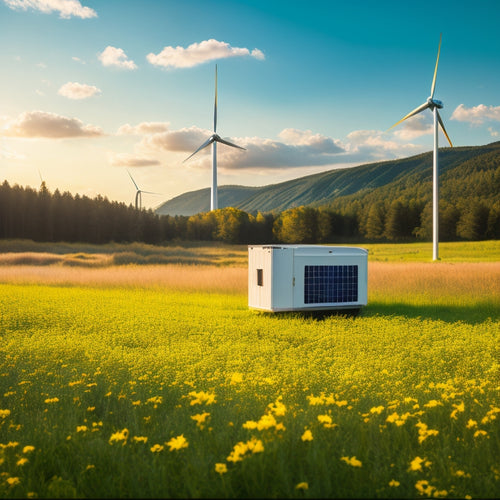
What Low Flow Showerhead Is Right for Your Home
Share
Choosing the right low flow showerhead for your home involves considering flow rates, spray patterns, and features. Look for models with flow rates of 2.5 GPM or lower to conserve water without sacrificing comfort. Adjustable settings and varying spray patterns can enhance your experience while optimizing efficiency. Opt for showerheads that incorporate advanced technologies like aerators to maintain water pressure. Quality materials, like stainless steel, guarantee longevity and performance. By making an informed selection, you'll not only lower your water bills but also contribute to sustainability. There's much more to investigate about maximizing your shower experience effectively.
At a Glance
- Consider flow rate standards; low flow showerheads should ideally be 2.5 GPM or less for optimal water efficiency and comfort.
- Look for customizable features such as adjustable settings and pause functions to enhance your shower experience while conserving water.
- Select models with eco-friendly certifications like WaterSense to ensure compliance with environmental standards and efficient water usage.
- Evaluate various spray patterns, like concentrated jets or rain shower sprays, to find the best comfort and performance for your preferences.
- Assess the long-term savings potential; low flow showerheads can significantly reduce water bills and overall water consumption by up to 50%.
Eco-Friendly Water Usage
When you consider eco-friendly water usage, it's crucial to assess the environmental impact of your choices.
Implementing water conservation techniques, like installing a low flow showerhead, can greatly reduce your water consumption. This not only benefits the environment but also helps lower your utility bills.
Additionally, adopting energy-efficient practices in your home, such as utilizing renewable energy solutions, can further enhance your overall sustainability efforts.
Environmental Impact Assessment
Choosing a low flow showerhead can considerably reduce your household's water consumption, ultimately leading to a smaller environmental footprint. By implementing sustainability practices in your home, you contribute to conserving essential resources and reducing strain on local water supplies.
Here's a quick comparison of water usage between standard and low flow showerheads:
| Type of Showerhead | Water Flow Rate (GPM) | Annual Water Consumption (Gallons) |
|---|---|---|
| Standard Showerhead | 2.5 | 24,000 |
| Low Flow Showerhead | 1.5 | 14,000 |
As shown in the table, switching to a low flow showerhead can save you around 10,000 gallons of water each year. This reduction not only lowers your utility bills but also lessens your ecological footprint.
With a simple adjustment, you're actively participating in the preservation of our planet's resources. Remember, every drop counts, and by choosing wisely, you enable yourself and others to adopt eco-friendly living. This choice cultivates a culture of awareness and responsibility towards our shared environment.
Water Conservation Techniques
Implementing water conservation techniques can greatly enhance your efforts in eco-friendly water usage at home. One effective method is rainwater harvesting, which involves collecting and storing rainwater for non-potable uses like irrigation and toilet flushing. By installing a rain barrel or a more sophisticated system, you can considerably reduce your reliance on municipal water sources.
Another strategy is greywater reuse. This method captures lightly used water from sinks, showers, and laundry to repurpose it for irrigation or toilet flushing. By setting up a greywater system, you can divert about 50-80 gallons of water per week, depending on your household size, directly back into your home's ecosystem.
Incorporating these techniques not only conserves water but also decreases your utility bills and minimizes your environmental footprint. It enables you to take control of your water usage, contributing to a more sustainable lifestyle.
To optimize these systems, guarantee proper filtration and maintenance to prevent contamination and promote efficiency. By making these choices, you're not just conserving water; you're redefining your relationship with this crucial resource, guaranteeing it's available for future generations.
Water Conservation Savings
Switching to a low flow showerhead can considerably reduce your water bills, as these fixtures use less water without sacrificing performance.
Additionally, like investing in solar energy, conserving water helps you save money while promoting environmental benefits, such as decreasing the strain on local water supplies and reducing energy consumption for heating water.
Understanding these savings helps you make an informed choice that positively impacts both your wallet and the planet.
Reduced Water Bills
Installing a low flow showerhead can substantially lower your water bills, making it an economically savvy choice for homeowners. By reducing the amount of water you use per shower, you'll notice significant water bill savings that can play an essential role in your household budgeting.
To illustrate the potential savings, consider the following table:
| Showerhead Type | Gallons Per Minute (GPM) | Average Showers Per Month | Total Gallons Used | Estimated Cost ($) |
|---|---|---|---|---|
| Standard Showerhead | 2.5 GPM | 30 | 7,500 | 75 |
| Low Flow Showerhead | 1.5 GPM | 30 | 4,500 | 45 |
Environmental Impact Benefits
While you may be focused on saving money, choosing a low flow showerhead also contributes greatly to water conservation efforts.
These fixtures can reduce your water usage by up to 50%, which not only helps the environment but also conserves a precious resource. By minimizing water flow without sacrificing performance, you're playing a crucial role in sustainability.
When selecting a low flow showerhead, consider the materials used in its construction.
High-quality materials can enhance durability and efficiency, guaranteeing your investment lasts longer and performs better. Look for models that feature eco-friendly certifications, as these often meet stringent environmental standards.
Installation tips are also important.
Most low flow showerheads are easy to install, typically requiring only a wrench and some plumber's tape. Make certain to follow the manufacturer's instructions to guarantee peak performance.
Spray Patterns and Settings
When selecting a low flow showerhead, consider the types of spray patterns available, as they can greatly impact your shower experience.
Some models even incorporate smart technology for enhanced efficiency and performance, similar to how high round-trip efficiency is essential in home energy storage systems.
Adjustable settings offer versatility, allowing you to customize water flow for different needs, whether you prefer a gentle mist or a stronger spray.
Understanding these options can enhance both comfort and efficiency in your daily routine.
Types of Spray Patterns
Choosing the right spray pattern can greatly enhance your shower experience while conserving water with a low flow showerhead. Understanding the various types of spray patterns available allows you to tailor your shower to your specific needs and user preferences.
One common spray pattern is the concentrated jet, which delivers a powerful stream of water, ideal for rinsing off soap or shampoo quickly.
Alternatively, a rain shower spray provides a gentle, enveloping experience that can be soothing and relaxing.
If you're looking for versatility, consider a showerhead with multiple settings, allowing you to switch between different patterns like mist, massage, or a combination of both.
Additionally, some showerheads include features like adjustable nozzles that can fine-tune the spray intensity and direction.
These features can notably enhance your comfort while still adhering to low flow standards.
Adjustable Settings Benefits
Adjustable settings on low flow showerheads offer significant benefits by allowing you to customize your shower experience. With various spray patterns and settings, these showerheads cater to your user preferences, guaranteeing that you enjoy both efficiency and comfort.
Here's a quick overview of common adjustable features:
| Feature | Benefit |
|---|---|
| Spray Patterns | Different patterns for various experiences, from gentle mist to powerful massage. |
| Flow Rate Options | Ability to select flow rates that balance water savings with your desired pressure. |
| Temperature Control | Allows you to maintain the perfect temperature throughout your shower. |
| Pause Function | Lets you temporarily stop water flow while lathering, saving water without sacrificing comfort. |
| Easy-to-Use Settings | Simple adjustments assure you can switch between settings effortlessly. |
These customizable features allow you to personalize your shower according to your mood or need. Whether you prefer a revitalizing rain-like experience or a focused jet, adjustable settings enable you to take control, enjoying both a satisfying shower and conservation benefits. Accept the freedom to choose how you shower while contributing to water-saving efforts.
Selecting Based on Flow Rate
When selecting a low flow showerhead, understanding flow rate standards is essential.
Most low flow models aim for a flow rate of 2.5 gallons per minute (GPM) or less, but you might find options that go as low as 1.5 GPM.
Choosing the right showerhead not only enhances your daily routine but also contributes to energy independence and autonomy by reducing water and energy consumption.
Knowing the ideal flow rates can help you balance water efficiency with a satisfying shower experience.
Understanding Flow Rate Standards
Understanding flow rate standards is vital for selecting an efficient low flow showerhead that meets your needs. Flow rate regulations often dictate that residential showerheads mustn't exceed 2.5 gallons per minute (GPM), but many low flow models operate at a mere 1.5 GPM or even lower. This difference can greatly impact your water consumption and utility bills.
When you're making showerhead comparisons, consider both the flow rate and the technology used in the design. Some models use air injection technology to maintain pressure while reducing water flow, resulting in a satisfying shower experience without excessive water use. Others may simply restrict flow, which could lead to a less enjoyable shower.
It's also important to check for certification labels, such as WaterSense, which indicate compliance with established flow rate regulations. These certified products not only save water but also guarantee performance standards are met.
Ideal Flow Rates Explained
Choosing the right flow rate for your showerhead can greatly enhance your shower experience while conserving water. Flow rates are typically measured in gallons per minute (GPM), and for low flow models, you'll find rates between 1.5 to 2.5 GPM.
Selecting the ideal flow rate depends on your personal preferences and the desired balance between water efficiency and comfort. If you prefer a strong spray, opt for a showerhead closer to the 2.5 GPM mark, while those seeking a gentler experience might choose a 1.5 GPM option.
Keep in mind that the materials of your showerhead can also influence performance. High-quality materials, such as stainless steel or durable plastics, can enhance water pressure and longevity.
When installing your new showerhead, consider a few installation tips. Verify the existing plumbing can accommodate your chosen flow rate, and always check for any flow restrictors that may need adjusting.
Superior Pressure Efficiency
When selecting a low flow showerhead, consider how water-saving technology directly impacts pressure efficiency.
These innovative designs optimize water flow, allowing you to enjoy a powerful shower while using considerably less water.
Water-Saving Technology Benefits
Low flow showerheads are revolutionizing the way we think about water usage in our daily routines. These innovative fixtures combine advanced engineering with efficient water flow mechanisms, allowing you to enjoy a satisfying shower experience while conserving water.
By incorporating specialized showerhead features, such as aerators and pressure-compensating technology, you'll maintain ideal water pressure without sacrificing comfort.
When you switch to a low flow showerhead, you'll notice a significant reduction in water consumption, often cutting usage by up to 50%. This not only helps the environment but also reduces your utility bills, giving you more freedom to allocate resources elsewhere.
The design of these showerheads guarantees that the spray remains invigorating, even with lower flow rates, so you won't feel like you're skimping on your daily indulgence.
Moreover, many low flow models come equipped with adjustable settings, allowing you to customize the experience to your liking. You can enjoy a powerful rinse or a gentle mist, all while being mindful of your water usage.
Embracing water-saving technology in your shower means you can enjoy the luxury of a great shower while making responsible choices for the planet.
Frequently Asked Questions
Are Low Flow Showerheads Compatible With All Plumbing Systems?
Yes, low flow showerheads are generally compatible with most plumbing systems. However, you should consider your water pressure, as some systems require specific pressure levels to function effectively and maintain an enjoyable shower experience.
How Do I Install a Low Flow Showerhead Myself?
Think of a DIY escapade—installing your low flow showerhead's a breeze! Grab your installation tools, turn off the water, unscrew the old showerhead, and attach the new one. Enjoy the showerhead benefits while saving water!
Can I Use a Low Flow Showerhead With a Handheld Shower?
Yes, you can use a low flow showerhead with a handheld shower. Just ascertain the flow restrictions meet your desired pressure. Handheld benefits include flexibility and ease of use, enhancing your shower experience without wasting water.
Do Low Flow Showerheads Require Special Maintenance?
Low flow showerheads don't require special maintenance beyond regular cleaning. You'll want to check water pressure and flow rate occasionally, ensuring ideal performance. A quick rinse of the nozzle can prevent mineral buildup and maintain efficiency.
What Materials Are Low Flow Showerheads Typically Made From?
Low flow showerheads typically use plastic, brass, or stainless steel materials. Each material type impacts durability factors, with brass offering longevity and plastic being lightweight. Choose based on your preference for durability and aesthetic appeal.
Explore More
Choosing the right low flow showerhead isn't just a decision; it's a revolution in your bathroom! With the right model, you'll change your daily routine into an eco-friendly oasis while slashing your water bills to a fraction of what they used to be. Imagine powerful sprays that rival a luxury spa, all while conserving water like a superhero. Don't underestimate the impact of this simple switch—your wallet and the planet will thank you in ways you never thought possible!
Related Posts
-

Is This the Future of Alternative Energy Systems
Yes, alternative energy systems are shaping the future of energy. Innovations in solar and wind technologies are driv...
-

Sustainable and Eco-Friendly Generators for a Reduced Carbon Footprint
Sustainable and eco-friendly generators are perfect for cutting your carbon footprint and increasing energy efficienc...
-

Essential Hiking Lights for Safety and Fun
When you're hitting the trails, essential hiking lights are vital for safety and fun. A lightweight headlamp offers h...


